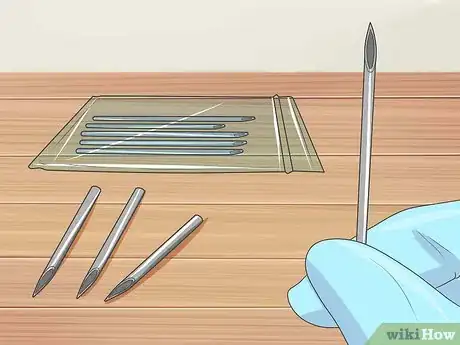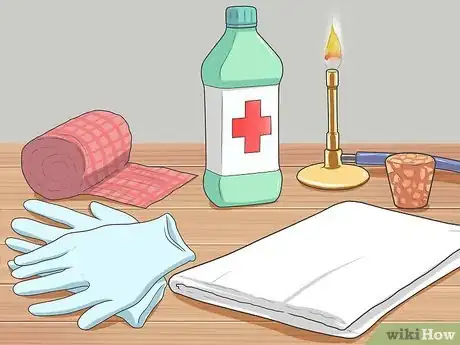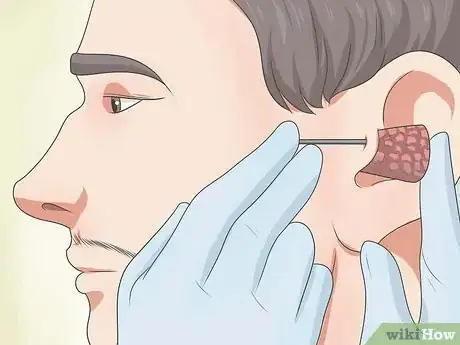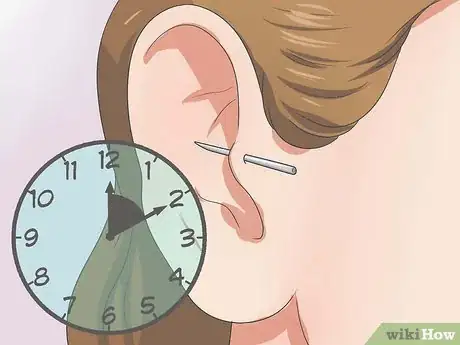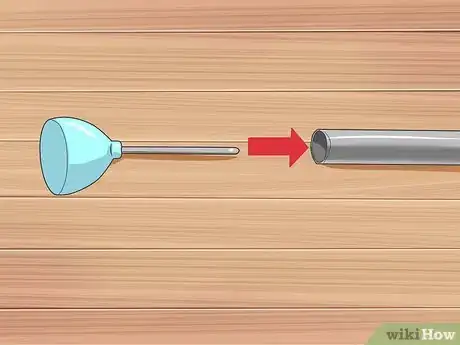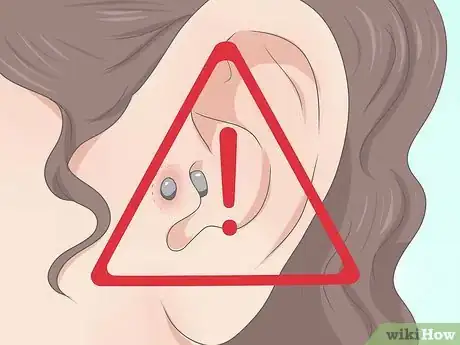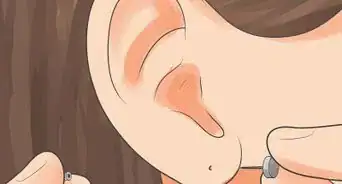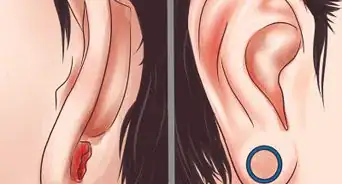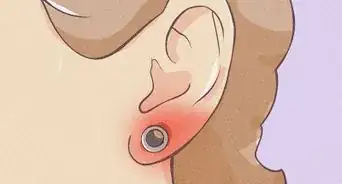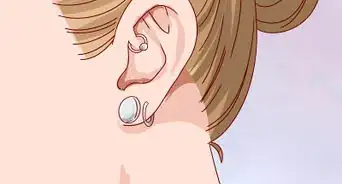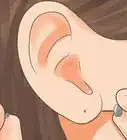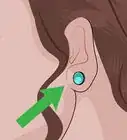wikiHow is a “wiki,” similar to Wikipedia, which means that many of our articles are co-written by multiple authors. To create this article, 35 people, some anonymous, worked to edit and improve it over time.
wikiHow marks an article as reader-approved once it receives enough positive feedback. In this case, 86% of readers who voted found the article helpful, earning it our reader-approved status.
This article has been viewed 203,724 times.
Learn more...
Cartilage piercings are becoming as popular as regular ear piercings, and many people who want them do not want to pay for a professional piercing. However, home piercings are dangerous and often lead to crooked or irregular piercings at best and infections at worse. You should always think about going to a professional for your piercing, but if you are dead-set on piercing your own ear at home, read on for tips and steps.
Steps
-
1Consider seeing a professional. Contrary to popular belief, piercing your own ear is neither easy nor safe. Professional body piercers have the experience, equipment, and environment needed to ensure a quick and clean piercing.
- Poorly performed piercings can lead to infection, bleeding, and nerve damage. You need to understand the risks if you want to continue.
- If you have any doubt, wait and see a professional for your piercing.[1]
-
2Choose an appropriate needle. Do not use a sewing needle or pin -- piercing needles are cheap online and are made for piercings. There are a surprising number of suitable needles, but there are only a couple of considerations for piercing your tragus. Your needle should be:
- Hollow
- One size, or gauge, bigger than your earring (ex. a 12 gauge needle for an 11 gauge earring)
- Curved (Optional). Most professionals use curved needles because they mimic the curve of your tragus. However, they are hard to maneuver and are not strictly necessary.
Advertisement -
3Prepare safety and sanitation supplies. You can never be too cautious with sanitation when piercing your own body. Remember, you are forming an open wound on your body and leaving it open for several weeks as it heals. This is the perfect place for germs to grow if you are not careful. Be sure to have:
- Gloves
- Cork
- Cotton Swags
- Gauze
- Disinfectant.
- Antiseptic fluid, bleach, rubbing alcohol, and an open flame for sterilization.
-
4Wash your hands and clean your ear. You can use soap and water or an over the counter antiseptic solution. If you use soap, choose antibacterial soap. Remember-- it is essential that your hands and equipment are as clean as possible.
-
5Sterilize everything. The importance of this step cannot be stressed enough. Use antibacterial wipes on every surface and sterilize the needle, earring and cork. Be sure to wash everything first with soap and water to remove any dirt or grime. There are two accepted ways to sterilize equipment:
- Sterile a needle by holding it over an open flame for 10-15 seconds. Do no touch the needle to the flame.
- Sterilize equipment by mixing equal parts water and bleach in shallow bowl. Submerge your equipment and leave it there for at least one minute. Rinse with clean water.
- Anytime that your hands or equipment becomes dirty or contaminated, repeat this process completely.
-
6Plan for complications. While the tragus is not a complicated piercing, you need to be prepared if you slip, faint, or pierce incorrectly. Have a friend nearby who can call emergency services if need be.
-
7Put a thick piece of cork behind your tragus. This allows you to hold your tragus steady and stops the needle from continuing after it has pierced your tragus. Plug the cork in your ear so that it rests comfortably against the back of your tragus.
- You may need to cut the cork in half to fit it in your ear, but make sure it is at least 1/2 inch thick.
-
8Line up the needle with a mirror. Make sure the needle rests in the middle of the tragus and is not crooked or angled. You can buy piercing markers as well to make a note where you want the earring if it helps. Never use regular markers, however, as the ink can enter your wound.
-
9Firmly press the needle straight through your tragus. Use quick, even force to push the needle through your ear and into the cork. Do not push at an angle or try to jerk the needle in. Keep calm and push the needle through with a fast but methodical motion.
- To relax your body before piercing, inhale deeply and then push as you begin to exhale.
- Do not stop halfway, as this will only prolong the pain.
-
10Leave the needle in for 10 minutes before removing it. While it is there, use your cotton swab and some rubbing alcohol or antiseptic to disinfect the wound.
- Gently twist and pull the needle to partially remove it. Leave a small amount of the needle in your ear -- this will help you put in the new earring easily.
-
11Thread the point of the earring into the hollow needle. Use the hollow point of the needle to guide the earring into your ear. Holding the earring in place, remove the rest of the needle so that only the earring remains. Clasp the earring shut.[2]
-
12Use gauze to lightly clean up any blood. You can dip the gauze in antiseptic or rubbing alcohol help sterilize the wound. Dispose of all materials
-
13Leave your new earring in for 4-6 weeks. This allows the skin to heal around the earring, leaving a small hole. If you take the earring out early the hole may close up, forcing you to repeat your piercing.
-
14Monitor your ear for signs of infection. For the next two weeks, keep you ear clean with soap and water to prevent an infection from building up. If you notice any of the following symptoms, leave the earring in and see a doctor immediately:
- Red or swollen skin
- Pain
- Green or yellow discharge
- Fever[3]
Community Q&A
-
QuestionCan I use a regular earring or does it need to be a special one?
 Community AnswerIt should be a special earring, because it needs to be large enough to go through your tragus. You should go to a professional to get this done so that they can provide you with the proper earring and care instructions, and ensure that it is done correctly.
Community AnswerIt should be a special earring, because it needs to be large enough to go through your tragus. You should go to a professional to get this done so that they can provide you with the proper earring and care instructions, and ensure that it is done correctly. -
QuestionWould it fall in my ear while sleeping?
 Community AnswerNo, it won’t fall in your ear if you have the backing on securely and tightly.
Community AnswerNo, it won’t fall in your ear if you have the backing on securely and tightly. -
QuestionWhy can't I put the needle in the tragus at an angle?
 Community AnswerIf you put it at an angle, the piercing may not take properly which could lead to serious problems.
Community AnswerIf you put it at an angle, the piercing may not take properly which could lead to serious problems.
Warnings
- Read all instructions and warnings before your continue, and make sure everything is sterilized.⧼thumbs_response⧽
- Know that everyone is different, and you may have risk factors that make these methods difficult or different for your ear.⧼thumbs_response⧽
- Never pierce your friends unless you are a professional. You put yourself at legal risk and are gambling with their safety as well.⧼thumbs_response⧽
Things You'll Need
- Piercing Needle
- Tragus Earring
- Gloves
- Cork
- Cotton Swags
- Gauze
- Disinfectant.
- Antiseptic fluid, bleach, or an open flame for sterilization.

